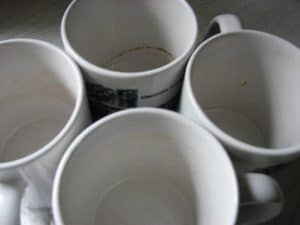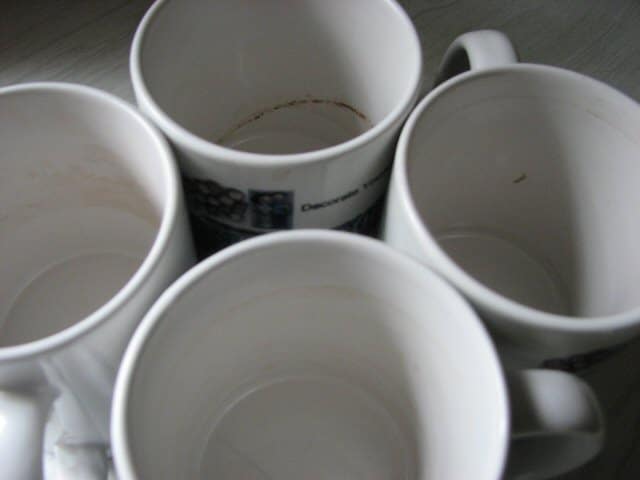As a homeowner, there is nothing more annoying than finding your cups still stained with coffee or tea stains on the inside when you empty the dishwasher. The coffee and tea stains appear as brown rings on the saucer, or in the cup. This stain may cover the saucer or the bottom of the cup.
In most cases, homeowners who notice this usually opt to rerun the dishwasher. Before doing so, they add more water and detergent. What many people don’t know is that the dishwasher is not always the culprit.
The following are reasons why dishwashers leave coffee and tea stains on cups and saucers:
- Using a low-temperature wash cycle – (use the highest temperature cycle to remove deep stains)
- Poor quality detergent
- Damp or stale detergent
- Coffee and tea stains are left to stand in the saucer or cup for a long time (multiple hot cycles will be needed)
- The water is hard (use salt)
- The cups and saucers are old
The solutions are usually the ones below, but read the whole article to find out why:
- Run the Intensive-Hot Dishwasher Program
- Two-Stage Dishwasher Program
- Soak the Spray Arm
- Clean Your Dishwasher
- Remove the Buildup Under the Coarse Filter
- Place Dishes (Glasses and Cups) for Better Cleaning
In some cases, the dishwasher may be losing its cleaning efficiency. Despite the reasons above, there are ways to ensure the dishwasher cleans the stubborn coffee and tea stains.

How to Use Your Dishwasher to Clean Stubborn Coffee and Tea Stains
You can solve the vast majority of dishwasher cleaning problems by running the dishwasher on the hottest cycle available or changing the detergent. However, there are more ways to get rid of the coffee and tea stains from your cups, saucers, and teapots.
Here, we discuss the different ways of using the dishwasher to clean stubborn coffee and tea stains.
Run the Intensive Dishwasher Program
Perfect for heavily soiled dishes and those with stubborn stains such as coffee or tea, this program uses a higher temperature. It also uses more water to clean the grime and stubborn stains from your dishes.
When you set your dishwasher to run under the intensive program, it will consume more energy and water than the energy-save or main programs. The good news is it eliminates the need to soak the cups with stubborn coffee and tea stains.
Remember, the intensive program is not suitable for all dishes. If you have ceramic coffee or teacups, teapots and saucers, then the high temperature will not cause any damage. But if the dishes are glass or plastic, the heat may cause damage.
If you have glass tea or coffee cups, saucers, and teapots, consider the delicate glassware dishwasher program.
Two-Stage Dishwasher Program
As the name suggests, the two-stage dishwasher program involves two washes. This means the dishwasher runs a single wash, followed by another. This program is perfect for heavily soiled dishes.
In fact, your coffee and tea-stained cups, saucers, and teapots will become clean in no time. Besides the two-stage dishwasher program, other dishwashers have an extra hygiene setting. This setting increases the duration of the program and temperature.
As such, it gives your dishes a more intense wash. This program is actually ideal for homes with allergy sufferers or children.

Other Ways to Clean the Tea/Coffee Stains
Besides selecting the dishwasher programs, there are different ways to ensure your coffee and teacups, saucers, and teapots are clean.
Soak the Spray Arm
One way of transforming your dishwasher into an efficient appliance is to remove bits of foods mechanically. These bits of foods clog the holes of the spray arm. To soak the spray arm, shut off your dishwasher and remove the arm.
Prepare a solution of white vinegar and soak the arm. There are two ways of doing this. First, place the spray arm on a four-sided cookie sheet and add the vinegar.
The other option is to add white vinegar in a glass bowl followed by the spray arm. Thanks to the active ingredients in the white vinegar, it helps to breakdown the scale and soap buildup.
Remember to put duct tape over the holes of the spray arm.
Clean Your Dishwasher
Modern dishwashers have a self-clean setting. Every few months, we recommend running this program to clean your dishwasher. The program cleans your dishwasher at a high temperature. By doing so, it removes and shifts dirt, finally cleaning the appliance.
Before running the self-clean program, inspect the interior of the dishwasher. Don’t be surprised when you find glass from broken dishes, toys, chunks of old food, and more. So, check the bottom of the dishwasher for debris.
Using your hands, feel around the bottom of the dishwasher. Reach down and remove any old food or muck. Wear kitchen rubber gloves before doing so. You can remove the coarse filter, which helps to catch big particles. Don’t forget to clean the fine filter too.
To run the program, make sure the appliance is empty. By running the self-clean program every few months, not only do you get rid of the dirt, but you keep your dishwasher in good condition. This helps to extend the life of your dishwasher and eliminates draining problems.
If you are not sure how to run the self-clean program, we recommend that you read the appliance manual for guidance.
Remove the Buildup Under the Coarse Filter
A lot of professional plumbers will confirm that residue builds up under the coarse screen. The residue is usually a mix of hard water minerals and soap. If the residue continues to build up, it will lower the cleaning efficiency of your dishwasher.
To clean or remove the buildup, prepare a mixture of baking soda and white vinegar. Apply the paste on the residue and allow it to sit for 15 to 20 minutes. To spread or scrape off the residue, use a plastic putty knife.
What you need to know is that you may have to repeat the procedure a few times to remove the residue properly.
How to Place Dishes (Glasses and Cups) for Better Cleaning
Homeowners buy some of the most sophisticated appliances and gadgets. They include digital cameras, smartphones, tablets, smart speakers, refrigerators, washing machines, and dishwashers. The problem is, a majority of homeowners do not take the time to read through the owner’s manual for guidance.
By not reading the manual and care instructions, many people do not learn how to place dishes in a dishwasher for better cleaning properly. Here is how to do it.
Cups and glasses should go on the top rack. You need to place them between the tines and not the top. If you do so, the tip of the prong leaves a water spot. For glasses wedged between two tines, they crack.
When placing cups on the top rack, make sure to angle them. Doing so ensures that water does not pool at the base of the upside-down cups. If you discover puddles when unloading, start by unloading the bottom rack to avoid any drip down.
To ensure wine glasses do not bump into each other and break, make sure they are sitting securely on the top rack. Modern dishwashers have unique stemware holders. These holders help to keep wine glasses stable.
Remember, never load any dishes on the top rack. They should go on the bottom rack, which is specially designed for them.
